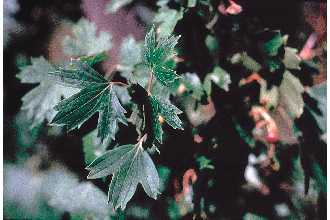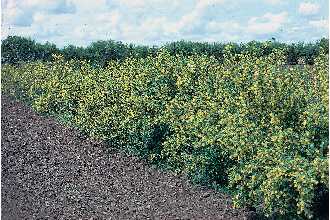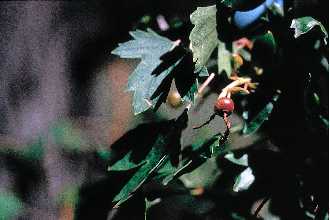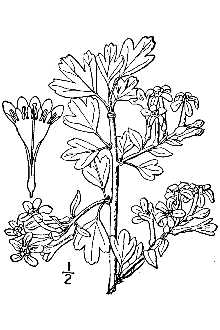Ribes odoratum H. Wendl.
Scientific Name: Ribes odoratum H. Wendl.
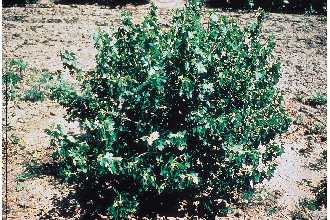
| General Information | |
|---|---|
| Usda Symbol | RIOD |
| Group | Dicot |
| Life Cycle | Perennial |
| Growth Habits | Shrub |
| Native Locations | RIOD |
Plant Guide
Alternate Names
Buffalo currant, fragrant golden currant, golden flowering currant, clove currant, spicebush
Uses
Wildlife: Fruits of Ribes species, including the golden currant, are a valuable food source for songbirds, chipmunks, ground squirrels, as well as numerous wildlife species and other animals. Ethnobotanic: The sweet and flavorful fruits are full of seeds but are popular for making jam, jelly, pie, and even ice cream. Some western Indian tribes used currants (Ribes species) for making pemmican. The Kiowa Indians believed that snakes were afraid of the currant bush and used it as a snakebite remedy. Other tribes have used the fruits to color clay pots. Conservation: The fragrant (clove odor), golden-yellow flowers of spring, yellowish to red fall foliage, edible fruits, and wide ecological range make golden currant a valued ornamental shrub for a variety of natural landscapes. Golden currant is easily cultivated from seed or cuttings. Botany Dept., NMNH, Smithsonian Institution @ PLANTS
Status
Please consult the PLANTS Web site and your State Department of Natural Resources for this plant’s current status, such as, state noxious status and wetland indicator values.
Description
General: Currant family (Grossulariaceae). A native shrub 1-3 m tall, spineless, with numerous, erect-arching branches forming an irregular crown up to 6 meters tall or more; bark gray to red-brown; rhizomatous. Leaves deciduous, light green and glossy, alternate or clustered, orbicular or cuneate-ovate with 3-5 rounded lobes, (0.6-)1-2.5(4.7) cm long and wide, cuneate to subcordate at base, glabrous or sometimes lightly hairy beneath. Flowers in short racemes of 5-10(-15), with the fragrance of cloves; long-tubed (from fused sepals) and trumpet-shaped, with 5 yellow sepal lobes spreading at the top, with 5, short, reddish petals inserted at the top of the tube. Fruit a berry 6-10 mm diameter, globose to ellipsoid, ripening from green to yellow to red and finally black to dark purple, with numerous seeds. The common name pertains to the conspicuous, golden flowers; “currant” is the general name for Ribes fruit. Variation within the species: Ribes odoratum, often considered a distinct species, recognized by its considerably larger flowers, has been placed (re-placed, as var. villosum) as the eastern segment of the broader species. Var. aureum – (golden currant) Var. gracillimum (Coville & Britt.) Jepson – (golden currant) Var. villosum DC. – (fragrant golden currant, buffalo currant, clove currant) synonym: Ribes odoratum H. Wendl. Distribution: Var. aureum is widespread in the western US and southeastern Canada, with populations in Ontario and perhaps Quebec, as far south in the US as trans-Pecos Texas. Var. gracillimum is endemic to California. Var. villosum in the central US, from western Texas to Montana and eastward to New York and Vermont; it is absent from the Atlantic seaboard. The species is naturalized in Europe from garden escapes. For current distribution, please consult the Plant Profile page for this species on the PLANTS Web site.
Adaptation
Golden currant grows in grasslands, coniferous forests and woodlands, and riparian and mountain shrub communities. It occurs on floodplains, along streams, in ravines and washes, by springs, and on mountain slopes, at elevations of about 800–2600 meters. It is generally an early to mid-seral species in western coniferous forests. Var. villosum occurs on cliffs, rocky slopes, ravines, bluffs, open hillside, and thicket margins, often in sandy habitats. Golden currant is somewhat shade tolerant and may grow in open, scattered, and dense pine stands, but it is usually suppressed by a denser canopy. Flowering (March–)April–June, just after appearance of the leaves; fruiting (May–)June–August.
Establishment
Plants of Ribes generally begin fruiting after 3 years. Seeds may remain viable in the soil and duff for many years. Germination is enhanced by scarification, but relatively good germination of golden currant seeds was obtained by stratification at -2.2–2.2 degrees C for 60 days without scarification. Golden currant transplants well and forms suckers. Plants can also be grown from cuttings. It reproduces vegetatively by rhizomes, sprouting after cutting and fire.
Management
Golden currant can be used to re-vegetate roadsides and disturbed areas, such as mine spoils and rangeland, It is rated mostly good in initial establishment, growth rate, persistence, germination, seed production, ease of planting, and natural spread, It tolerates shearing and may be used on dry, exposed sites in a range of soil types, and it is a good soil stabilizer, Golden currant is an alternate host for white pine blister rust (Cronartium ribicola); this and other species of Ribes have been targets of various eradication efforts where white pine is of commercial interest, Please check the PLANTS Profile for this plant for links to additional information, Fire top-kills golden currant, but it can survive low- to moderate-severity fire by sprouting from rhizomes, Such fires also scarify soil-stored seed and enhance germination, Severe fire probably kills golden currant and may destroy soil-stored seeds, Use soil moisture sensors to measure the soil moisture of Ribes odoratum H. Wendl.., Cultivars, Improved and Selected Materials (and area of origin) These plant materials are readily available from commercial sources, One cultivar (‘Crandall’) has been referred to as "the North Country's answer to Forsythia," Other horticultural selections have been made for hardiness, flower color and density, and fruit taste and size, Contact your local Natural Resources
Conservation
Service (formerly Soil Conservation Service) office for more information. Look in the phone book under ”United States Government.” The Natural Resources Conservation Service will be listed under the subheading “Department of Agriculture.”
References
Conrad, C. E. 1987. Common shrubs of chaparral and associated ecosystems of southern California. Gen. Tech. Rep. PSW-99. USDA, Forest Service, Pacific Southwest Forest and Range Experiment Station, Berkeley, California. Shaw, N. 1984. Producing bareroot seedlings of native shrubs. IN: P.M. Murphy (compiler). The challenge of producing native plants for the Intermountain area. Proceedings, Intermountain Nurseryman's Association conference; Las Vegas, NV, 1983. Gen. Tech. Rep. INT-168. USDA, Forest Service, Intermountain Forest and Range Experiment Station, Ogden, Utah. Wasser, C.H. 1982. Ecology and culture of selected species useful in revegetating disturbed lands in the West. FWS/OBS-82/56. USDI, Fish and
Wildlife
Service, Washington, DC. Winkler, G. 1987 (rev. K.A. Marshall 1995) Ribes aureum. IN: W.C. Fischer (compiler). The fire effects information system [Data base]. USDA Forest Service, Intermountain Research Station, Intermountain Fire Sciences Laboratory, Missoula, Montana.
Fact Sheet
Alternate Names
Buffalo currant, fragrant golden currant, golden flowering currant, clove currant, wild currant, clove bush
Uses
Golden currant has been widely planted for wildlife habitat, ground cover, watershed protection, and in conservation plantings. Golden currant is a highly preferred spring and midsummer browse for big game with only moderate summer and light fall grazing by big game animals. Golden currant is an excellent species for stabilization of roadways and other disturbances, particularly when transplanted stock is utilized. Both bare root and containerized plants will establish well on disturbed sites. Golden currant is also widely used for hedges, windbreaks and in conservation and landscape plantings. It is usually planted in combination with other woody species. This species is also planted in hedges or rows to provide berries for jam and jelly production. Some Native American tribes used currants for making pemmican; a high protein, high energy food made with meat, fat and fruit in a dry, edible form.
Status
The golden currant is a widespread species that is the alternate host for the pine blister rust fungus; this has caused the species to be a target for eradication in areas where white pine is of economic and commercial value. Please consult the PLANTS Web site and your State Department of Natural Resources for this plant’s current status (e.g., threatened or endangered species, state noxious status, and wetland indicator values).
Description and Adaptation
Adaptation , Use soil moisture sensors to measure the soil moisture of Ribes odoratum H. Wendl..
Adaptation
Figure 2. Golden currant distribution from USDA-NRCS PLANTS Database. Golden currant belongs to the Grossulariaceae or currant family. Golden currant is an unarmed, irregularly shaped, multi-stemmed shrub 3 to 10 feet tall that spreads by suckering. The reddish bark of young twigs turns gray with age. Leaves are simple, alternate, deciduous, and petiolate. Leaf blades are ovate with a cuneate to chordate base, usually glaborous, and palmately three lobed with the lobes being entire, toothed, or lobed. In May, either before or as leaves appear, golden currant produces many racemes of ¾ to 1 inch long yellow tubular flowers that emit a pleasant clove or spicy odor. The cylindrical hypanthium consists of five spreading calyx lobes alternating with five shorter erect petals. The perfect flowers are initially golden yellow, but turn reddish with age. The edible fruit is a globose, glabrous, many seeded berry. Fruit colors vary from yellow, to red orange to black. The large fruit, up to ½ inch in diameter, is excellent for human and wildlife consumption. The minute embryo is embedded in a large amount of endosperm. Golden currant is generally not widely abundant, but it occurs as scattered plants, patches, and clumps in
Establishment
Fruits are hand harvested by stripping them from branches or by flailing them into containers as soon as they ripen. Few wild land stands are large enough to produce much seed. Collection of 100 pounds of fruit will only yield about 4 pounds of usable seed. Thus, seed collection costs are high and limit the use of this shrub in large scale plantings. Fruits are processed by maceration in water to separate the fruit pulp from the seed. Pulp and empty seeds are separated from sound seeds by floatation. There are 200,000 to 285,000 seeds per pound. Seed viability is normally quite high, usually in excess of 75 percent. Seed germination can be hastened and increased by a long period of cold, moist stratification. A wet prechill of 60 to 90 days at 28 to 36 degrees Fahrenheit (°F) is often sufficient to reduce embryo dormancy. Seeds retain good viability for 5 to 17 years if stored cool and dry in sealed containers.
Management
Seeds should be fall planted to provide a cold, moist period for maximum germination. Seeds are small, round, and easily dispersed by most seeders. Golden currant can be seeded alone or more commonly in mixtures with other woody shrub and forb species. Seeds are usually sown at a rate of 0.25 to 2.0 pounds per acre depending on mixture components, method of seeding and row spacing. In a nursery setting, seeds are usually sown at a rate of 60 to 80 seeds per square foot or 40 viable seed units per linear foot of row. Seed should be planted 0.25 inches deep on a firm, weed free seed bed. Adding mulch to the soils surface is recommended for nursery beds subject to rapid drying and crusting of the soil surface. Seeds that germinate often due so uniformly and initial emergence is usually very good even under range or wild land conditions. Compared with most shrubs, seedlings of golden currant are very persistent. Seedlings grow rapidly and generally attain heights of 6 to 12 inches the first year of growth. Seedlings of few other shrubs are as vigorous as this species. Bareroot or containerized transplants can be quickly grown. Planting beds are normally thinned to the correct spacing and density. One year old transplants develop a dense, well branched root system, and field survival of 1-0 transplants is usually high. Transplants establish well on harsh disturbed sites due, in part to their well developed root system. Container stock is grown from seed or hardwood or softwood cuttings.
Pests and Potential Problems
Currants are subject to defoliation by western tent caterpillars and they are the alternate host for white pine blister rust (Cronartium ribicola). A bacterial spot (Pseudamonas syringae pathovar ribicola) can cause severe defoliation of golden currant and necrotic spots to form on leaves, shoots and fruit.
Control
Please contact your local agricultural extension specialist or county weed specialist to learn what works best in your area and how to use it safely. Always read label and safety instructions for each control method. Trade names and control measures appear in this document only to provide specific information. USDA NRCS does not guarantee or warranty the products and control methods named, and other products may be equally effective. Cultivars, Improved, and Selected Materials (and area of origin) These plants are readily available from commercial sources. The cultivar ‘Crandall’ was discovered by R.W. Crandall of Newton, Kansas and introduced into commercial production by Frank Ford and Sons, Nursery, Ravenna, Ohio, in 1888. Fruit of this clone is mild, sweet, pleasant, and very different from European black currants. It performs well in hot summers, is resistant to white pine blister rust, and shows little or no damage from powdery mildew in Idaho and Oregon trials. Prepared By: Richard L. Wynia, USDA-NRCS Manhattan Plant Materials Center
Plant Traits
Growth Requirements
| Temperature, Minimum (°F) | -46 |
|---|---|
| Adapted to Coarse Textured Soils | Yes |
| Adapted to Fine Textured Soils | Yes |
| Adapted to Medium Textured Soils | Yes |
| Anaerobic Tolerance | Low |
| Cold Stratification Required | No |
| Drought Tolerance | Medium |
| Fire Tolerance | Low |
| Frost Free Days, Minimum | 128 |
| pH, Maximum | 7.8 |
| pH, Minimum | 4.7 |
| Planting Density per Acre, Maxim | 5120 |
| Planting Density per Acre, Minim | 1280 |
| Precipitation, Maximum | 60 |
| Precipitation, Minimum | 12 |
| Root Depth, Minimum (inches) | 12 |
Morphology/Physiology
| C:N Ratio | Medium |
|---|---|
| Toxicity | None |
| Shape and Orientation | Decumbent |
| Resprout Ability | No |
| Low Growing Grass | No |
| Nitrogen Fixation | None |
| Bloat | None |
| Coppice Potential | No |
| Fall Conspicuous | No |
| Fire Resistant | No |
| Flower Color | Red |
| Flower Conspicuous | Yes |
| Foliage Color | Green |
| Foliage Porosity Summer | Dense |
| Foliage Porosity Winter | Porous |
| Fruit/Seed Color | Black |
| Fruit/Seed Conspicuous | No |
| Growth Form | Thicket Forming |
| Height at 20 Years, Maximum (fee | 10 |
| Height, Mature (feet) | 3.0 |
| Known Allelopath | No |
| Leaf Retention | No |
| Lifespan | Short |
| Foliage Texture | Medium |
Reproduction
| Propagated by Seed | No |
|---|---|
| Propagated by Sod | No |
| Propagated by Sprigs | No |
| Propagated by Tubers | No |
| Propagated by Bare Root | No |
| Seed per Pound | 200000 |
| Seed Spread Rate | Moderate |
| Seedling Vigor | Medium |
| Small Grain | No |
| Propagated by Corm | No |
| Propagated by Container | No |
| Propagated by Bulb | No |
| Fruit/Seed Persistence | No |
| Fruit/Seed Period End | Summer |
| Fruit/Seed Period Begin | Spring |
| Bloom Period | Spring |
| Propagated by Cuttings | Yes |
Suitability/Use
| Veneer Product | No |
|---|---|
| Pulpwood Product | No |
| Post Product | No |
| Palatable Human | Yes |
| Palatable Graze Animal | Low |
| Palatable Browse Animal | Medium |
| Nursery Stock Product | No |
| Naval Store Product | No |
| Lumber Product | No |
| Fodder Product | No |
| Christmas Tree Product | No |
| Berry/Nut/Seed Product | No |

